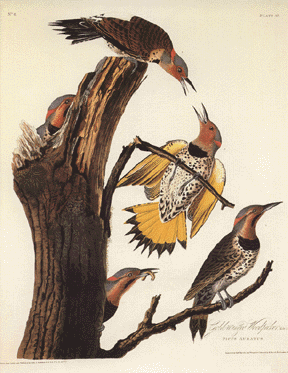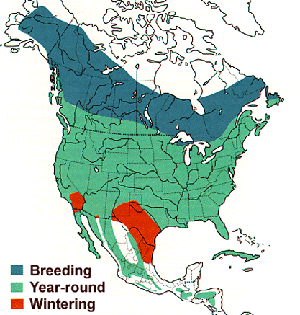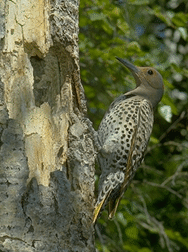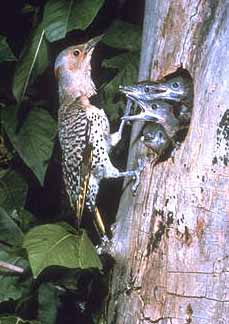Identification
and Overview
| The
Northern Flicker is a large, brown woodpecker. Flickers spend much of their
time on the ground where they hop around in search of ants and other insects.
There are several kinds in both North and South America.
This 12 inch, medium-sized woodpecker has a long, narrow black bill and are browth with black barring on upper parts and wings. They have a prominent white rump and a blackish-brown tail. They have a black crescent in the center of the chest and a whitish breast and belly with some black markings. |
|
| Yellow-shafted Flicker (Eastern race): Has a gray head and a large patch or red on the lower nape. Males have a black moustache stripe on a cinnamon face and upper breast. Underwings and undertail coverts are yellow, giving the race its name. |  |
| Red-shafted Flicker (Western race): Has a cinnamon head and a nape that lacks the red patch. The face and upper breast is gray with a prominent red moustache stripe. The underwings and undertail coverts are salmon pink in color. | |
|
|
|
|
|
|
| Conservation
Status
Though a common species, the Breeding Birds Survey shows that numbers are declining, especially in the Yellow-shafted race (down 52% between 1966 and 1991). Possibilities for this decline include the decline in habitat, the use of pesticides on lawns and other feeding areas, and competition with the European Starling for nest cavities. |
|
| Yellow-shafted Race of Northern Flicker | |
Diet
Northern Flickers are the "anteaters" of avians.
They feed mostly on the ground, unlike other woodpeckers, and frequent
lawns and leaf litter. This diet is reflected by evolution:
they lack the "super-hammering apparatus" of most woodpeckers, meaning
they cannot drill into hard wood. Instead, they need soft or rotten
trees for nest-holes. Though it eats mainly ants, it also eats beetle
larvae, and even berries in late autmn, winter, and early spring.
They have even been known (in Montana) to catch young bats leaving their
roosts.
Foraging Behavior
Forages by hopping on the ground. Will climb
treetrunks and limbs, occasionally flying out to catch insects in the air.
Additionally, they will perch on brances to eat fruit berries.
| The Northern Flicker's range extends throughout North America. In the breeding season, they can be found as far north as the tree line and as far south as Central America. The northern most ones willmigrate to the southern United States to winter from the Southwest to Florida. | ||
 |
 |
|
| Above: Yellow-shafted
race female
Left: Northern Flicker (general) Range |
||
Northern populations of the Yellow-shafted race are strongly migratory, funneling into the southeastern United States in late autumn and returning to northern breeding grounds in the early spring. Southern populations are sedentary. Most birds appear to reach breeding grounds by April 7th. The average date when first seen in Pennsylvania is March 15th to 22nd, in Cape May, NJ April 5th. Migrates in loose flocks that reportedly vary in size from a few individuals to a hundred. Migration is mostly nocturnal. Ornithologists have reported continuous departures of hundreds of flickers across Lake Erie throughout morning during fall migration.
Data shows that the Red-shafted race is inclined to "over-winter" at or near breeding areas. Northern most populations are also migratory. They become rare or absent in British Columbia in the winter. Their numbers increase in fall and winter in California as migrants arrive from north. California breeders move from higher to lower elevations during the winter and may migrate from the state. Altitudinal migration also appears to happen from the Rocky Mountains to the Great Plains. Fall migration begins in late August and peaks in mid- to late-September. Little is known about migratory behavior.
 |
Species appear to be monogamous. |
| Male defends nest territory by drumming and making aggressive dispays. He will swing his head back and forth while flicking his wings and tails open to show the bright underside. |
Nesting
| Location: In a tree or post, favoring dead or soft wood. 6-20 feet above ground. Sometimes nests in a ground burrow. |  |
| Construction: A cavity excavated by both sexes in a tree. | |
| Clutch Size: 5-8, sometimes 3-12 white eggs | |
| Number of Broods: 2 per year. 1 in the South and 1 in the North. | |
| Incubation: Both sexes incubate for 11-16 days. The male incubates during the night and part of the day. | |
| Parental Care: The young leave the nest about 4 weeks after hatching and begin following their parents to foraging sites to learn to feed. | |
Kaufman, K. (1996). The Lives of North American Birds. New York: Houghton Mifflin.
Moore, W.S. (1995). "Northern Flicker (Colaptes Auratus)" in The Birds of North America. No. 166 (A. Poole and F. Gill, eds.). The Academy of Natural Sciences, Philadelphia, and the American Ornithologists' Union, Washington, D.C.
Flicker Website for Kids: http://www.worldbook.com/fun/wbla/camp/html/walkflic.html
BirdSource: http://www.birdsource.cornell.edu/pfw/birdid/original%20texts/nofl.htm
Audubon's Pictures: http://www.jjaudubon.com
Northern Flicker Nest Box: http://www.npwrc.usgs.gov/resource/tools/ndblinds/nortflic.htm
Peterson Online: http://www.petersononline.com/birds/month/nofl/
Other: http://www.baylink.org/wpc/cflicker.html